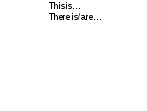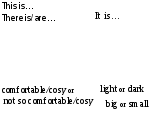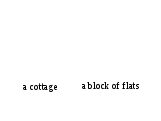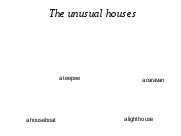- Преподавателю
- Иностранные языки
- Разработка уроков по теме дом с использованием опор
Разработка уроков по теме дом с использованием опор
| Раздел | Иностранные языки |
| Класс | 6 класс |
| Тип | Другие методич. материалы |
| Автор | Хорошева Е.Н. |
| Дата | 29.09.2015 |
| Формат | docx |
| Изображения | Есть |






 Муниципальное автономное образовательное учреждение дополнительного профессионального образования (повышения квалификации) специалистов
Муниципальное автономное образовательное учреждение дополнительного профессионального образования (повышения квалификации) специалистов
«Центр аналитики и методологии образования»
Муниципальное автономное образовательное учреждение
«СОШ №30»
Конспекты непосредственной образовательной деятельности
для детей младшего школьного возраста
«Разработка уроков по теме "My House"»
Разработала:
Хорошева Елена Николаевна
Учитель английского языка
МАОУ СОШ №30
Занятие проведено в рамках недели английского языка
приобщенной к традиционному английскому празднику «Рождество»
Директор ЦАМО О.В.Змазова
Березники, 2015
Тема: My Flat
Задачи:
1) семантизировать лексику по теме «My Flat»;
2) активизировать лексику в монологических высказываниях;
3) ввести оборот there is/are , there isn't/aren't;
4) практиковать в аудировании с извлечением конкретной информации;
5) тренировать в построении монологических высказываний с использованием вербальных и изобразительных опор
Оборудование: изображения комнат, раздаточный материал
Ход урока
Этапы
Деятельность учителя
Деятельность учащихся
Примечания
-
1.Организационный момент
-
2. Основное содержание
Семантизация лексики
Аудирование с извлечением конкретной информации
Введение грамматического оборота there is/are, there isn't/aren't
Тренировка грамматического оборота there is/are, there isn't/aren't
Ознакомление с построением вопроса
Тренировка в построении вопросов
Построение монологического высказывания с помощью вербальной и изобразительной опор
-
Заключительный этап
- Good morning, children. I'm glad to see you. Today we'll start a new topic which is called "My Flat". We'll learn the new words and expressions and try to describe the rooms.
- First, let's learn the words. You have some pictures of rooms on your desks.
- Find the picture #1. Let's read the words. Try to remember them.





- You see some things are repeated in different rooms. Name the things of the bedroom ( the living-room, the kitchen, the bathroom, the dining-room)
-Nick tells about his favourite room of his house. Listen and fill in the scheme. In the center you should write the name of the room. And around the central word write what things are there in the room.
?
-What kind of room is it?
-What is there in the room?
-Look at the screen and guess which of this rooms is the boy's one?
Для того, чтобы описать комнату или указать на наличие или отсутствие какого-либо лица или предмета в определённом месте, мы используем структуру there is/are
Repeat after me there is, there are
Оборот there is употребляется, если за ним следует существительное в единственном числе. Например: There is a table in the room.
Оборот there are употребляется, если за ним следует существительное во множественном лице. Например: There are flowers in the vase.
Для того, чтобы сказать, что чего-то нет в указанном месте, нужно поставить после is/are частицу not
- Now, let's train a little. Find the cards #2. Put the right verb is or are. Work in a chain
There (is/are) a desk in the room.
There (is/are) a sofa in the living-room.
There (is/are) books on the shelf.
There (is/are) curtains in the bedroom.
There (is/are) a picture on the wall.
-Look at the picture. Say what there isn't in the room. Use the structure
There isn't or There aren't

Для того, чтобы задать вопрос, нужно поставить is или are в начале предложения. Например: Are there chairs in the room? Is there a shelf in the bedroom?
-Let's play the game. Each of you has the pictures of the rooms. You have to ask what there is/are in your room.
-Look at the example on the screen:
Is there a bedroom?
Yes, there is (there are)/ No, there isn't (there aren't)
-Read the example.
-Work in pairs for 3 minutes.
Let's listen to some of you.
-There are different kinds of rooms. Look at the picture and say what is there in the hall. Work in a chain.
There is/are… in the hall.

-Now watch a part of the cartoon and tell about the room.
(просмотр видеофрагмента)
-Tell about the room.
-Your hometask will be to draw the picture of the room and give the description of it and at the next lesson we'll listen to some of you.
-Our lesson has come to the end. I liked your working very much. You were active. Stand up. Goodbye
- Good morning
T-Cl, P1-P2
A room: a door, windows, the ceiling, the floor, the wall, the corner
A living-room: a lamp, a sofa, an armchair, a bookshelf, a carpet, a TV set, a stereo, a wall unit,
A bedroom: a bed, a wardrobe, a desk, a mirror
A kitchen: a chair, a stove, a refrigerator, a sink
A dining-room: a
table, curtains
A bathroom: a bath, a sink, a shelf, a toilet
P1, P2
Двухразовое прослушивание
P1: the living-room
P1:
P1:
T-Cl
T-Cl
P1-P2-P3
P1-P2-P3
There aren't shelves. There isn't a picture. There isn't a table. There isn't a bed. There isn't a door. There isn't an armchair. There isn't carpet.
P1
P1< - > P2
P1-P2
-Is there a bed?
-Yes, it is.
-Is there a table?
-Yes, it is.
P1
This is a hall. There is a table. There is a lamp on the wall. There is a vase in the corner. There is a carpet on the floor.
P1-P2
This is a bedroom. There is a bed. There is a picture on the wall. There is a big shelf with the toys. There is a carpet on the floor
Каждой паре предоставляется серия рисунков с изображениями комнат и наименованиями предметов в них
Дети продолжают работать с теми же картинками. Некоторые предметы обозначены знаком вопроса, дети должны их назвать
Опоры в виде схемы
Изображения трёх комнат
На доске написано: there is/are
Примеры на экране:there is a table in the room. There are flowers in the vase
Карточки №2, каждой паре
отсутствующие предметы на экране. Опора there isn't, there aren't
Примеры на экране: Are there chairs in the room? Is there a shelf in the bedroom?
Образец на экране
Изображение гостиной
Изображение спальни
Видеофрагмент из мультика
Тема: My Flat. The rooms
Задачи:
1) совершенствовать речевых умений монологической речи с использованием вербальных и изобразительных опор;
2) активизировать употребление ранее изученных лексических единиц по теме, грамматического оборота there is/are
3) познакомить с грамматическим оборотом there was/were;
Оборудование: раздаточный материал, листы формата А4, вырезки мебели и предмет быта, фломастеры, карандаши, клей, запись видеофрагмента
Ход урока
Этапы
Деятельность учителя
Деятельность учащихся
Примечания
-
Организационный момент
-
Основное содержание
Активизация лексики
Проверка домашнего задания
Построение монологического высказывания с помощью ЛСС
Введение грамматического оборота there was/were, построение монолога с опорой на подстановочную таблицу
Физкультминутка
Построение монолога с опорой на план
Выполенеие мини-проекта коллажа «Комната моей мечты», построение монолога с опорой на коллаж
-
Заключительный этап
-Good morning, dear children. I'm glad to see you. I hope you are fine. Today we'll continue speaking about our houses and flats.
-English people say "East or West, home is best"
-Let's read it all together
-Try to translate it and find the Russian equivalent.
-Let's remember the names of the rooms and furniture we have in our houses and flats. Read the poem and translate the words in brackets from Russian into English. Don't forget about the articles.
In a big old house,
Many years ago,
There were two happy monsters
Called Albert and Joe.
They played in (кухня)
They played in (прихожая)
They played in (гостиная)
They played with the ball.
They went in (столовая)
And counted (стулья)
They walked past (туалет)
And went up (лестница)
They went in (спальня)
And jumped on (кровать)
They went in (ванная)
And painted it red.
-What kinds of rooms are mentioned in the poem?
-That's true. You see there are different kinds of rooms. At home you have to describe one of the rooms. Let's listen to some of your descriptions.
-Now look at the picture. Let's learn some new words. Read and translate them.

-Here is the same room as it was before.
-Когда мы хотим указать на наличие или отсутствие какого-либо предмета в определённом месте в прошлом мы употребляем оборот there was/were. There was/were - это прошедшее время оборота there is/are. Сравните:
There is a desk in the room.
There was a desk in the room.
Describe the room using the table.
I think the room was
I don't think the room was
comfortable
cosy
nice
because
there was/were
there wasn't/weren't
-First, let's read the new words and expressions from the table and translate them.
-Make up your own story.
-It's high time to have a rest. Stand up, look at me and do as I do.
Look at the ceiling
Look at the door
Look at the window
Look at the floor
Point to the ceiling
Point to the door
Point to the window
Point to the floor
We are drawing the ceiling
We are drawing the door
We are drawing the window
We are drawing the floor
-That's great. Sit down.
-We study in the room too. Describe it. Don't forget to mention about:
-
Is it large or small?
-
What colour are the walls?
-
What are there on the walls?
-
How many desks are there?
-
How many windows are there?
-
Are there any flowers?
-
Are there any shelves?
-Work in pairs for 5 minutes.
-Let's listen the full description
-What kind of the room would you like to have?
-Make the room you'd like to have using the pictures. Be ready to describe it.
5 minutes for your work.
-Let's see what you have done.
-You have done well. During the lesson we've spoken about the rooms. Your work was very intensive. Your marks are…
-The lesson is over. Good bye.
-Good morning
T-Cl
P1: Восток ли, запад ли, дом лучше. В гостях хорошо, а дома лучше
P1-P2-P3-P4
the kitchen
the hall
the living-room
the dining-room
the chairs
the toilet
the stairs
the bedroom
the bed
the bathroom
P1: the kitchen, the hall, the living room, the dining-room, the toilet, the bedroom, the bathroom
P1-P2
P1-P2-P3
P1, P2
P1-P2-P3
P1, P2
I think the room is cosy because there is a TV set opposite the sofa, a carpet on the floor and the picture on the wall.
P1-P2
P1
Gr1, Gr2, Gr3
Gr1, Gr2, Gr3
Выступление групп, защита мини-проектов
Пословица на экране
Карточки #1 со стихотворением для каждой пары
Изображение гостиной
Comfortable, cosy, not so comfortable/cosy, dark, light, big, small
Вербальная опора
This is…
There is/are…
It is…
Изображение гостиной, опора в виде подстановочной таблицы на пару
Опора в виде плана на экране
Листы формата А3, вырезки с изображением мебели и предметов быта для каждой группы, клей, фломастеры, карандаши
Тема: My House Is My Castle
Задачи: 1) активизировать лексики по теме "My Flat";
2) практиковать в устной монологической речи с использованием вербальных и изобразительных опор;
3) практиковать в чтении с извлечением конкретной информации;
4) практиковать в аудировании с извлечением конкретной информации
Оборудование: раздаточный материал
Ход урока
Этапы
Деятельность учителя
Деятельность учащихся
Примечания
-
Организационный момент
-
Основное содержание
Введение новой лексики
Построение монологического высказывания с вербальной опорой
Чтение текстов с извлечением конкретной информации
Построение монологических высказываний с опорой на текст
Построение монолога с помощью ЛСС
-
Заключительная часть
-Good morning, boys and girls.
-Listen to the poem and say what we are going to talk about.
Some people live in the country
Where the houses are very small,
Some people live in the city
Where the houses are very tall
But in the country
Where the houses are small
The gardens are very big.
And in the city
Where the houses are tall
There no gardens at all.
Where do you live?
-What are we going to talk about?
-That's true. The topic of our lesson is "My House Is My Castle".
-Let's read it all together.
-It is the favourite proverb of British people. How do you understand it? Read and choose the best suitable variant:
1) My home likes me
2) I like my home
3) I am safe at home
-Houses may be different. Look at the scheme.
small
The house medium
big
-Let's read the words.
-Look at the pictures and say what houses you see.

-That's great. Also there are two types of houses. Look at them.
-Repeat after me: a cottage, a block of flats
-Translate the words.
-I live in a medium block of flats, where do you live?
-Start your sentence with the following words
I live in…
-Now let's see the specific features of the houses. Look at the table.
-Let's read the information and translate it.
Types of the houses
location
Specific features
A cottage
(a private house)
A block of flats
In a village,
Out of the city
In the city, seldom in the village
Small, comfortable, nice, there is a garden
Big, medium, there are a lot of flats, comfortable, cosy, there is a balcony
-What is special about the cottage?
-What is special about a block of flats?
-Where would you like to live and why?
I'd like to live in … because…
-Some people in Britain live in the unusual houses. Look at the pictures.

-Repeat after me: a lighthouse, a teepee, a caravan.
-The owners of the houses have different opinions about them. Let's read them and find out their advantages and disadvantages.
1) We live in a lighthouse. It's great. We live near the sea and I can go swimming every day. The lighthouse is far from the town. It is quiet there. I go to school by bicycle. There are only two rooms and a kitchen. But the rooms are very cosy and romantic.
2) In summer we lived in a caravan. We lived in a quiet area, not far from the school and shops. There was only one room and a place where to cook.
3) It is romantic and unusual to live in a teepee. But we have not got electricity and gas. And it is very small for a family.
-Find the advantages of the unusual houses.
-Find the disadvantages of the unusual houses.
-Would you like to live in one of these houses? Why? Share your opinion with your partner.
1) I'd like to live in … because…
It is…
There is/are…
2) I wouldn't like to live in … because…
It is (not) …
That's why…
-Let's listen to your opinions.
-Today we spoke about the types of the houses and unusual ones. I liked your work very much. You were active and bright.
-Our lesson has come to the end. Stand up. Good bye.
-Good morning.
P1: about the houses
T-Cl
P1: I am safe at home
P1
P1-P2
T-Cl
P1: частный дом, многоквартирный дом
P1-P2
I live in a small cottage. I live in a big block of flats. I live in a medium cottage.
P1-P2
P1
P1
P1-P2-P3
I'd like to live in a cottage because it is comfortable and there is a garden.
I'd like to live in a block of flats because it is cosy and there is a balcony.
T-Cl
P1-P2-P3
P1-P2
You can go swimming every day. It is quiet there. You can go to school by bicycle. It's romantic to live in a teepee.
P1-P2
The lighthouse is far from the town. There are only two rooms and a kitchen. There is no electricity and gas. The rooms are very small for a family.
P1<->P2
P1
I'd like to live in a lighthouse because it is near the sea and you can go swimming every day. It' is quiet there. You can go to school by bicycle.
-Good bye.
Пословица на экране
Варианты на экране
Градиентная опора
Изображения маленького дома, среднего дома, большого дома
Изображение многоквартироного и частного домов
Вербальная опора на экране
Таблица
Опора на экране
Изображения домов
Тексты на листочках
Опоры на экране


